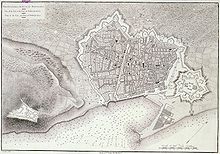Parc de la Ciutadella
Parc de la Ciutadella ( Catalan for "Citadel Park") is a park in Barcelona .
It is located on the northeastern edge of the administrative district Ciutat Vella (Catalan for "old town") and is bordered by the streets "Passeig Pujades", "Carrer de Wellington", "Passeig de Circumval·lació" and "Passeig de Picasso". It has ten entrances and an area of 17.42 hectares, not including the Barcelona Zoo.
The former arsenal of the citadel is now the seat of the Catalan Parliament .
Origins
The only urban park for many years was built on the former site of the city's citadel. The Jardin du Luxembourg in Paris served as a model for the design.
The park is located on the site where Philip V had a citadel built after the War of the Spanish Succession in the 18th century . On September 11th, 1714, after a siege of more than 13 months by King Philip V, Barcelona fell. In order to have the city firmly under control, he had the largest star-shaped citadel in Europe built.
The citadel was part of a complex for the complete military domination of Barcelona. The fortress Castell de Montjuïc was also built on the local mountain Montjuïc in order to be able to control the city from above. The Flemish military engineer Joris Prosper Van Verboom was responsible for the construction between 1716 and 1718.
Parts of the La Ribera district were demolished for the construction . It took three decades to move the residents to the newly built district of Barceloneta . 1,200 houses were demolished, as well as the Sant Agustí and Santa Clara monasteries. The Rec Comtal channel had to be diverted. A total of around 4,500 people were resettled who received no compensation and were left to their fate.
Demolition of the citadel
The citadel became a hated symbol of the central government in Madrid for the people of Barcelona . The Junta de Vigilancia ordered the demolition in 1841. Since the citadel was not completely destroyed, María Cristina de Borbón ordered the restoration two years later .
During the revolution of 1868 the citadel was permanently destroyed. The demolition began with the San Juan Tower, the military prison on the armory of the citadel. What remained of the original fortress are the chapel, the governor's palace (now an upper secondary school, the IES Verdaguer) and the arsenal, now the seat of the Catalan Parliament.
The park

The park, designed by Josep Fontserè i Mestre in 1870 , is one of the largest in Barcelona. Within its grounds is the zoo , as well as several remaining buildings of the fortress (the chapel, the governor's palace and the arsenal) and the 1888 World's Fair ( Umbracle , Hivernacle , Castell dels Tres Dragons ).
The complex stands out for its large green area, the many trees and walking paths as well as the lake and the waterfall, the Cascada of Fontserè i Mestre. The lake, the center of the park with several islands and an abundance of exotic plants and aquatic animals, can be ridden by rowing boats. On the old parade ground there is an oval basin with the sculpture Desconsuelo by Josep Llimona .
Other sculptures characterize the park such as the Monument General Prim by Lluís Puiggener (1887), demolished and melted down during the Spanish Civil War and recreated by Frederic Marès in 1940, as well as the Monument Bonaventura Carles Aribau by Manel Fuxà (1884), the Monument Walt Disney by Núria Tortras (1969) and the Mammut by Miquel Dalmau.
Web links
- Parc de la Ciutadella on the website www.barcelona.de (German)
- Parc de la Ciutadella on the website irBarcelona.de (German)
- Information about the Parc de la Ciutadella of the Universitat de Barcelona (Spanish)
Coordinates: 41 ° 23 '17.2 " N , 2 ° 11' 15.1" E

